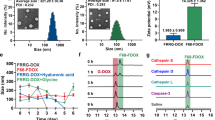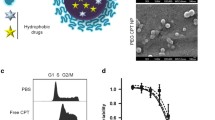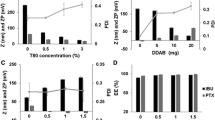Abstract
Purpose
Development of a nanoplatform constructed by the PEG-dual drug conjugation for co-delivery of paclitaxel (PTX) and Dihydroartemisinin (DHA) to the tumor.
Methods
PEG was conjugated with PTX and DHA to form PTX-PEG-DHA complex as a nanocarrier. The PTX and DHA were co-encapsulated in PTX-PEG-DHA nanoparticles (PD@PPD NPs) by the emulsion evaporation method. The physicochemical properties of PD@PPD Nps were characterized, including size, zeta potential, and morphology. The drug loading capacity and entrapment efficiency, in vitro drug release at different pH conditions were also evaluated. For in vitro assessment, the effects of the NPs on HT-29 colorectal cancer cells, including intracellular uptake, cytotoxicity, and Bcl-2 protein expression were assessed. The in vivo distribution of the NPs was investigated by labelling the NPs with Cyanine 5.5 fluorophore. Finally, the antitumor efficacy of the NPs was evaluated in HT-29 tumor-bearing mice.
Results
The nanoparticles were formed at small size (~114 nm) and narrow distribution. The combination of PTX and DHA in the DHA-PEG-PTX nanosystems (PD@PPD) showed remarkably increased apoptosis in colorectal adenocarcinoma HT-29 cells, as compared to free drug treatment. More importantly, the PD@PPD nanoparticles exhibited significantly higher accumulation in the tumor site owing to the enhanced permeability and retention (EPR) effect, effectively restrained the tumor growth in vivo at low-dose of PTX while reducing the systemic toxicity.
Conclusions
The combination of PTX and DHA in a PEG-conjugated dual-drug co-delivery system can minimize the severe side effect associated with the high-dose of PTX while enhancing the antitumor efficacy.






Similar content being viewed by others
Abbreviations
- PTX:
-
Paclitaxel
- DHA:
-
Dihydroartemisinin
- PEG:
-
Polyethylene glycol
- NPs:
-
Nanoparticles
- RES:
-
Reticuloendothelial system
- DLS:
-
Dynamic Light Scattering
- PDI:
-
Polydispersity Index
- EPR:
-
Enhanced permeability and Retention
- TEM:
-
Transmission electron microscopy
References
Soe ZC, Ou W, Gautam M, Poudel K, Kim BK, Pham LM, et al. Development of Folate-functionalized PEGylated Zein nanoparticles for ligand-directed delivery of paclitaxel. Pharmaceutics. 2019;11(11):562.
Zeng N, Hu Q, Liu Z, Gao X, Hu R, Song Q, et al. Preparation and characterization of paclitaxel-loaded DSPE-PEG-liquid crystalline nanoparticles (LCNPs) for improved bioavailability. Int J Pharm. 2012;424(1–2):58–66.
Dai Phung C, Tran TH, Kim JO. Engineered nanoparticles to enhance natural killer cell activity towards onco-immunotherapy: a review. Arch Pharm Res. 2020:1–14.
Cho H-J. Recent progresses in the development of hyaluronic acid-based nanosystems for tumor-targeted drug delivery and cancer imaging. Journal of Pharmaceutical Investigation. 2020;50(2):115–29.
Tran BN, Nguyen HT, Kim JO, Yong CS, Nguyen CN. Developing combination of artesunate with paclitaxel loaded into poly-d, l-lactic-co-glycolic acid nanoparticle for systemic delivery to exhibit synergic chemotherapeutic response. Drug Dev Ind Pharm. 2017;43(12):1952–62.
Aung W, Sogawa C, Furukawa T, Saga T. Anticancer effect of dihydroartemisinin (DHA) in a pancreatic tumor model evaluated by conventional methods and optical imaging. Anticancer Res. 2011;31(5):1549–58.
Chen Y, Chin BW, Bieber MM, Tan X, Teng NN. Artemisinin derivatives synergize with paclitaxel by targeting FOXM1 through Raf/MEK/MAPK signaling pathway in ovarian cancer. In: AACR. 2014.
Wang L, Wang Y, Wang X, Sun L, Zhou Z, Lu J, et al. Encapsulation of low lipophilic and slightly water-soluble dihydroartemisinin in PLGA nanoparticles with phospholipid to enhance encapsulation efficiency and in vitro bioactivity. J Microencapsul. 2016;33(1):43–52.
Nam W, Tak J, Ryu JK, Jung M, Yook JI, Kim HJ, et al. Effects of artemisinin and its derivatives on growth inhibition and apoptosis of oral cancer cells. Head & Neck: Journal for the Sciences and Specialties of the Head and Neck. 2007;29(4):335–40.
Feng M-X, Hong J-X, Wang Q, Fan Y-Y, Yuan C-T, Lei X-H, et al. Dihydroartemisinin prevents breast cancer-induced osteolysis via inhibiting both breast cancer cells and osteoclasts. Sci Rep. 2016;6:19074.
Ba Q, Zhou N, Duan J, Chen T, Hao M, Yang X, et al. Dihydroartemisinin exerts its anticancer activity through depleting cellular iron via transferrin receptor-1. PLoS One. 2012;7(8):e42703.
Efferth T. Cancer combination therapies with artemisinin-type drugs. Biochem Pharmacol. 2017;139:56–70.
Jianping S, Qin X. Combined medicine containing artemisinin and paclitaxel and application of combined medicine. In. China; 2015.
Zhang H, Hu H, Zhang H, Dai W, Wang X, Wang X, et al. Effects of PEGylated paclitaxel nanocrystals on breast cancer and its lung metastasis. Nanoscale. 2015;7(24):10790–800.
Ekladious I, Colson YL, Grinstaff MW. Polymer–drug conjugate therapeutics: advances, insights and prospects. Nat Rev Drug Discov. 2018;1.
Kim Y-C, Min KA, Jang D-J, Ahn TY, Min JH, Yu BE, et al. Practical approaches on the long-acting injections. Journal of Pharmaceutical Investigation. 2020;50(2):147–57.
Lu J, Chuan X, Zhang H, Dai W, Wang X, Wang X, et al. Free paclitaxel loaded PEGylated-paclitaxel nanoparticles: preparation and comparison with other paclitaxel systems in vitro and in vivo. Int J Pharm. 2014;471(1–2):525–35.
Dai L, Wang L, Deng L, Liu J, Lei J, Li D, et al. Novel multiarm polyethylene glycol-dihydroartemisinin conjugates enhancing therapeutic efficacy in non-small-cell lung cancer. Sci Rep. 2014;4:5871.
Deutsch H, Glinski J, Hernandez M, Haugwitz R, Narayanan V, Suffness M, et al. Synthesis of congeners and prodrugs. 3. Water-soluble prodrugs of taxol with potent antitumor activity. J Med Chem. 1989;32(4):788–92.
Horwitz SB, Cohen D, Rao S, Ringel I, Shen H-J, Yang C. Taxol: mechanisms of action and resistance. J Natl Cancer Inst Monogr. 1993;15:55–61.
Ačkar Đ, Babić J, Jozinović A, Miličević B, Jokić S, Miličević R, et al. Starch modification by organic acids and their derivatives: a review. Molecules. 2015;20(10):19554–70.
Meng H, Xu K, Xu Y, Luo P, Du F, Huang J, et al. Nanocapsules based on mPEGylated artesunate prodrug and its cytotoxicity. Colloids Surf B: Biointerfaces. 2014;115:164–9.
Wang Z. 597. Steglich catalyst (Steglich esterification). Comprehensive Organic Name Reactions and Reagents. 2010:2651–2655.
ZHU K, FAN Q, X-s ZHANG, SUN P, LEI J. HPLC quantitative determination of dihydroartemisinin in dihydroartemisinin and piperaquine phosphate tablets. Chinese Journal of Pharmaceutical Analysis. 2007;27(9):1484–6.
Dai Phung C, Nguyen HT, Tran TH, Choi H-G, Yong CS, Kim JO. Rational combination immunotherapeutic approaches for effective cancer treatment. Journal of controlled release. 2018.
Truong DH, Tran TTP, Nguyen HT, Phung CD, Pham TT, Yong CS, et al. Modulating T-cell-based cancer immunotherapy via particulate systems. J Drug Target. 2019;27(2):145–63.
Nguyen HT, Dai Phung C, Thapa RK, Pham TT, Tran TH, Jeong J-H, et al. Multifunctional nanoparticles as somatostatin receptor-targeting delivery system of polyaniline and methotrexate for combined chemo–photothermal therapy. Acta Biomater. 2018;68:154–67.
Tran TH, Tran TTP, Nguyen HT, Dai Phung C, Jeong J-H, Stenzel MH, et al. Nanoparticles for dendritic cell-based immunotherapy. Int J Pharm. 2018;542(1–2):253–65.
Ramasamy T, Ruttala HB, Chitrapriya N, Poudal BK, Choi JY, Kim ST, et al. Engineering of cell microenvironment-responsive polypeptide nanovehicle co-encapsulating a synergistic combination of small molecules for effective chemotherapy in solid tumors. Acta Biomater. 2017;48:131–43.
Kumar S, Bajaj S, Bodla RB. Preclinical screening methods in cancer. Indian journal of pharmacology. 2016;48(5):481–6.
Pham TT, Nguyen HT, Dai Phung C, Pathak S, Regmi S, Ha D-H, et al. Targeted delivery of doxorubicin for the treatment of bone metastasis from breast cancer using alendronate-functionalized graphene oxide nanosheets. J Ind Eng Chem. 2019;76:310–7.
Nguyen HT, Soe ZC, Yang KY, Dai Phung C, Nguyen LT-T, Jeong J-H, et al. Transferrin-conjugated pH-sensitive platform for effective delivery of porous palladium nanoparticles and paclitaxel in cancer treatment. Colloids Surf B: Biointerfaces. 2019;176:265–75.
Nguyen HT, Tran TH, Thapa RK, Dai Phung C, Shin BS, Jeong J-H, et al. Targeted co-delivery of polypyrrole and rapamycin by trastuzumab-conjugated liposomes for combined chemo-photothermal therapy. Int J Pharm. 2017;527(1–2):61–71.
Tang H, Zhang H, Ye H, Zheng Y. Receptor-mediated endocytosis of nanoparticles: roles of shapes, orientations, and rotations of nanoparticles. J Phys Chem B. 2017;122(1):171–80.
Kutuk O, Letai A. Alteration of the mitochondrial apoptotic pathway is key to acquired paclitaxel resistance and can be reversed by ABT-737. Cancer Res. 2008;68(19):7985–94.
Maji S, Panda S, Samal SK, Shriwas O, Rath R, Pellecchia M, et al. Bcl-2 Antiapoptotic family proteins and Chemoresistance in Cancer. Adv Cancer Res. 2018;137:37–75.
Cheng X, Liu Q, Li H, Kang C, Liu Y, Guo T, et al. Lipid nanoparticles loaded with an antisense oligonucleotide Gapmer against Bcl-2 for treatment of lung cancer. Pharm Res. 2017;34(2):310–20.
Dai Phung C, Thuy Nguyen H, Choi JY, Pham TT, Acharya S, Timilshina M, et al. Reprogramming the T cell response to cancer by simultaneous, nanoparticle-mediated PD-L1 inhibition and immunogenic cell death. J Control Release. 2019.
Ahn S, Seo E, Kim K, Lee SJ. Controlled cellular uptake and drug efficacy of nanotherapeutics. Sci Rep. 2013;3(1):1997.
Shuai Q, Zhao G, Zhang X, Yu B, Lee RJ, Su W-K. Selection of fluorescent dye for tracking biodistribution of paclitaxel in live imaging. Biointerfaces: Colloids and Surfaces B; 2019.
Funding
This research is funded by the Vietnam National Foundation for Science and Technology Development (NAFOSTED) under grant number 108.05–2017.300.
Author information
Authors and Affiliations
Corresponding authors
Ethics declarations
Conflict of Interest
The authors report no conflicts of interests.
Additional information
Publisher’s Note
Springer Nature remains neutral with regard to jurisdictional claims in published maps and institutional affiliations.
Electronic supplementary material
ESM 1
(DOCX 1324 kb)
Rights and permissions
About this article
Cite this article
Phung, C.D., Le, T.G., Nguyen, V.H. et al. PEGylated-Paclitaxel and Dihydroartemisinin Nanoparticles for Simultaneously Delivering Paclitaxel and Dihydroartemisinin to Colorectal Cancer. Pharm Res 37, 129 (2020). https://doi.org/10.1007/s11095-020-02819-7
Received:
Accepted:
Published:
DOI: https://doi.org/10.1007/s11095-020-02819-7




